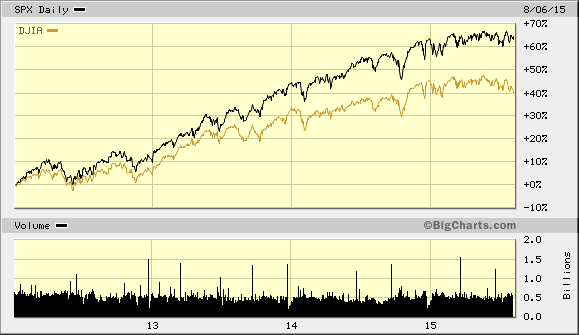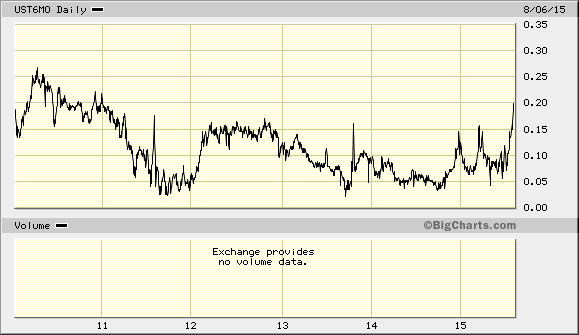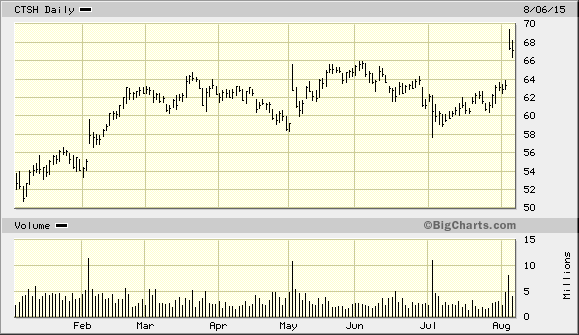CWS Market Review – August 7, 2015
“The first principle is that you must not fool yourself,
and you are the easiest person to fool.” – Richard Feynman
On Thursday, the Dow fell for the sixth day in a row. While that’s a newsworthy headline, truthfully, it tells us little about what the market’s been up to and more about how irrelevant the Dow has become.
For more than three years, the Dow has badly lagged the S&P 500, and it’s done particularly poorly in recent weeks (see below). That’s what happens when you’re weighted down with commodity stocks like Chevron (CVX) and Exxon (XOM). Yes, this too is a manifestation of the strong dollar. To paraphrase Comrade Trotsky, “you may not be interested in the forex market, but the forex market is interested in you.” The surging dollar has impacted everything.
Fortunately, the overall market is still holding up well. The S&P 500 continues to be locked comfortably inside its trading range. Not once this year has the index closed the day more than 3.5% from its New Year’s Eve close. Bespoke Investment Group notes that the S&P 500 has crossed its 50-day moving average 31 times this year. That’s tied for the second-most ever, and we’re only in early August. It’s just one big treadmill.
In this week’s CWS Market Review, I want to take a look at some of the recent economic data. Slowly, the economy continues to grow. The expansion is weak, but it shows few signs of trouble. We also had an outstanding earnings report from Cognizant Technology Solutions (CTSH). The IT outsourcer did our favorite two-step, the beat-and-raise shuffle. It’s now our top-performing stock this year with a 27.4% gain. Later on, I’ll cover some of our other Buy List stocks. But first, let’s take a closer look at the economy and why we can expect a Fed rate hike soon.
Expect the Fed to Raise Rates in September
Last week, the government released its initial report on Q2 GDP. They said that the economy expanded by 2.3% in real terms during the second three months of the year. Frankly, that’s pretty blah. I had been expecting a little more.
But there were some positive nuggets in this report. For example, Q1 GDP growth was revised up to 0.6% from a decline of 0.2%. Consumer spending, which is 70% of the economy, rose by 2.9% in Q2. That was probably helped by lower oil prices. Speaking of which, the energy sector is feeling the pain. Spending on mines and exploration fell a stunning 68.2% in Q2. That’s the biggest quarterly drop since 1986.
The government also revised the GDP data back in 2011, and it showed that the economy didn’t do as well as originally thought. This continues to be the weakest recovery since the end of World War 2. It will also likely be one of the longest.
The day after the GDP report came out, the Employment Cost Index (ECI) report was released, and it was terrible. It showed that American workers got their smallest wage increase in 33 years. The ECI, which is the broadest measure of labor costs, rose by just 0.2% in the second quarter. That was well below Wall Street’s expectations of 0.6%.
The reaction to the ECI on Wall Street was interesting. Initially, traders thought the Fed might not be so eager to raise rates with wage growth so tepid. Not so fast. The central bank has been dropping not-so-subtle clues that rates are going up, and going up soon.
If you recall, James Bullard, the president of the St. Louis Fed, recently said that there’s a good chance the Fed will hike rates at its next meeting, scheduled for September 16-17. I’ve said I was a doubter, but I need to reconsider my stand.
This week, Dennis Lockhart, the top dog at the Atlanta Fed, told the Wall Street Journal that the Fed is ready to move. This surprised me because Lockhart is generally considered to be a centrist. So if the Fed isn’t going to be dissuaded by a lousy ECI report, then they’re not going to be dissuaded by anything.
The bond market has reacted accordingly. The six-month Treasury yield closed Thursday at 0.2% (chart below). Sure, that’s not much, but it’s the highest yield since 2010. But the long end of the bond market is still pretty tame. One indicator I like to watch is the spread between the two- and ten-year Treasuries. This week, the 2-10 spread dropped down to 1.48%, which is the narrowest since April.
On Monday, the ISM Manufacturing Index for July came in at 52.7. That’s low, but it’s still positive. Any reading above 50 means the manufacturing sector is expanding, so it’s good to see improvement here. On Wednesday, the ISM Non-Manufacturing Index rose to 60.3. That’s very good—it’s a 10-year high. The ISM Employment Index jumped to 59.6, which is also a ten-year high. So you can see where Lockhart and Bullard are getting their optimistic views.
This week, the government also reported that personal income rose 0.4% in June while personal spending was up by 0.2%. That’s not bad, but remember that was back in Q2, and we’re nearly halfway through Q3. More recent data suggest people are still spending money. On Monday, for example, the automakers reported good sales figures for July. Trucks and SUVs are especially hot. This was good news for our very own Ford Motor (F). The New York Times reported, “S.U.V.s also powered Ford’s gains in July, with nearly its entire lineup posting double-digit growth. The Ford Explorer was up 23 percent, the Edge up 17 percent and the Escape up 10 percent.” Ford is still a buy up to $17 per share.
As much as I discuss the possibility of a Fed rate hike, we should put this in some context. Even after an increase, short-term rates will still be below inflation, and it appears likely that will last for quite some time. In fact, if we look at one of the Fed’s preferred inflation metrics, core PCE, we see that inflation rose from 1% annualized in Q1 to 1.8% in Q2. That means that even if the Fed raises rates by 0.25% or 0.50%, real rates will be lower than they were at the start of the year. There’s little reason to believe that the Fed’s plans will upset the stock market. Historically, it’s taken several rate hikes to wake up the bears. Now let’s look at our final Buy List earnings report for Q2.
Cognizant Beats and Raises Guidance
Three months ago, Cognizant Technology Solutions (CTSH) told us they expected to earn at least 72 cents per share for Q2. In last week’s CWS Market Review, I told you they “should easily beat” that, and I was right. Cognizant had a great quarter. Their healthcare business was especially strong.
For Q2, Cognizant earned 79 cents per share. Quarterly revenue rose 22.6% to $3.08 billion. The consensus on Wall Street had been for $3.03 billion. All down the line, this was a very good quarter for CTSH.
Best of all, Cognizant raised its full-year guidance. For Q3, CTSH expects earnings of at least 75 cents per share on revenue of at least $3.14 billion. Previously, Cognizant had said it expected full-year earnings of at least $2.93 per share. On Wednesday, it raised that to at least $3 per share. The revenue forecast increased from at least $12.24 billion to at least $12.33 billion.
Traders liked what they saw. Shares of CTSH jumped 6.4% on Wednesday. The stock has reclaimed its crown as our #1 performer on the year, with a YTD gain of 27.4%. This week, I’m raising my Buy Below on Cognizant Technology to $70 per share. Well done, lads.
2015 Is a Solid Year for Our Buy List So Far
I don’t like to focus too much on our Buy List’s performance over the short term, but permit me a small indulgence: Our Buy List has been kicking some serious butt lately. Thanks to stocks like Cognizant, this earnings season has been a very good one for us. Since July 17, the S&P 500 is down 2.03%, while our Buy List is up 0.92%. We’ve beaten the S&P 500 ten times in the last 12 days.
Through Thursday, our Buy List is up 6.61% on the year, compared with 1.20% for the S&P 500 (dividends not included). We now have 10 stocks up double digits on the year including six that are up more than 19%.
Our lead against the S&P 500 is so big that if our position in Stryker (SYK) suddenly plunged to $0 for a 100% loss, we’d still be beating the market. This is shaping up to be the eighth time in the last nine years that our Buy List has beaten the market. Best of all, we haven’t made a single trade all year.
Bed Bath & Beyond Is a Buy up to $65 per Share
One Buy List stock that’s not been a good performer of late has been Bed Bath & Beyond (BBBY). On Thursday, the home-furnishings stores closed at $63.19, its lowest price since October.
What’s gone wrong? Let’s take a step back and see where we stand. In June, Bed Bath & Beyond reported Q1 earnings of 93 cents per share. Not great, but it was within their guidance of 90 to 95 cents per share. The key metric is comp-store sales, which rose 2.2%. BBBY’s guidance had been for 2% to 3%. OK, but again, what we expected.
For Q2, which ends in August, Bed Bath said they expect earnings to range between $1.18 and $1.23 per share. That’s not great guidance, but it’s not terrible either. But ever since that report, the stock has been a loser.
In June, the company reiterated its full-year guidance was for earnings to rise between 0% and 5%. Since they earned $5.07 per share last year, that translates to an earnings range of $5.07 to $5.32 per share. That means the stock is going for about 12 times this year’s earnings. I think that’s a very good deal.
What I like about Bed Bath & Beyond is that they generate tons of cash, and they’ve been using much of it to buy back stock. Unlike many other companies, BBBY actually reduces its share count. I like that. What I don’t like is its spending so much money on a stock that’s down 17% on the year. That’s throwing good money after bad.
Last week, I cut my Buy Below on BBBY to $70 per share. I’m going to take the unusual step of cutting it again by $5 to $65 per share. I’ll warn you that this is a riskier play, but I think the market has overreacted. I’m going to keep our Buy Below pretty tight here.
That’s all for now. No Buy List earnings reports next week, but there will be some key economic reports. On Tuesday, the Labor Department reports on Q2 productivity. The retail-sales report comes out on Thursday. On Friday, we get industrial production and capacity utilization. Our two Buy List stocks with quarters ending in July are due to report in the week after next. Hormel Foods (HRL) will report on August 19, and Ross Stores (ROST) will be on August 20. Be sure to keep checking the blog for daily updates. I’ll have more market analysis for you in the next issue of CWS Market Review!
– Eddy
Posted by Eddy Elfenbein on August 7th, 2015 at 7:08 am
The information in this blog post represents my own opinions and does not contain a recommendation for any particular security or investment. I or my affiliates may hold positions or other interests in securities mentioned in the Blog, please see my Disclaimer page for my full disclaimer.
- Tweets by @EddyElfenbein
-
-
Archives
- April 2024
- March 2024
- February 2024
- January 2024
- December 2023
- November 2023
- October 2023
- September 2023
- August 2023
- July 2023
- June 2023
- May 2023
- April 2023
- March 2023
- February 2023
- January 2023
- December 2022
- November 2022
- October 2022
- September 2022
- August 2022
- July 2022
- June 2022
- May 2022
- April 2022
- March 2022
- February 2022
- January 2022
- December 2021
- November 2021
- October 2021
- September 2021
- August 2021
- July 2021
- June 2021
- May 2021
- April 2021
- March 2021
- February 2021
- January 2021
- December 2020
- November 2020
- October 2020
- September 2020
- August 2020
- July 2020
- June 2020
- May 2020
- April 2020
- March 2020
- February 2020
- January 2020
- December 2019
- November 2019
- October 2019
- September 2019
- August 2019
- July 2019
- June 2019
- May 2019
- April 2019
- March 2019
- February 2019
- January 2019
- December 2018
- November 2018
- October 2018
- September 2018
- August 2018
- July 2018
- June 2018
- May 2018
- April 2018
- March 2018
- February 2018
- January 2018
- December 2017
- November 2017
- October 2017
- September 2017
- August 2017
- July 2017
- June 2017
- May 2017
- April 2017
- March 2017
- February 2017
- January 2017
- December 2016
- November 2016
- October 2016
- September 2016
- August 2016
- July 2016
- June 2016
- May 2016
- April 2016
- March 2016
- February 2016
- January 2016
- December 2015
- November 2015
- October 2015
- September 2015
- August 2015
- July 2015
- June 2015
- May 2015
- April 2015
- March 2015
- February 2015
- January 2015
- December 2014
- November 2014
- October 2014
- September 2014
- August 2014
- July 2014
- June 2014
- May 2014
- April 2014
- March 2014
- February 2014
- January 2014
- December 2013
- November 2013
- October 2013
- September 2013
- August 2013
- July 2013
- June 2013
- May 2013
- April 2013
- March 2013
- February 2013
- January 2013
- December 2012
- November 2012
- October 2012
- September 2012
- August 2012
- July 2012
- June 2012
- May 2012
- April 2012
- March 2012
- February 2012
- January 2012
- December 2011
- November 2011
- October 2011
- September 2011
- August 2011
- July 2011
- June 2011
- May 2011
- April 2011
- March 2011
- February 2011
- January 2011
- December 2010
- November 2010
- October 2010
- September 2010
- August 2010
- July 2010
- June 2010
- May 2010
- April 2010
- March 2010
- February 2010
- January 2010
- December 2009
- November 2009
- October 2009
- September 2009
- August 2009
- July 2009
- June 2009
- May 2009
- April 2009
- March 2009
- February 2009
- January 2009
- December 2008
- November 2008
- October 2008
- September 2008
- August 2008
- July 2008
- June 2008
- May 2008
- April 2008
- March 2008
- February 2008
- January 2008
- December 2007
- November 2007
- October 2007
- September 2007
- August 2007
- July 2007
- June 2007
- May 2007
- April 2007
- March 2007
- February 2007
- January 2007
- December 2006
- November 2006
- October 2006
- September 2006
- August 2006
- July 2006
- June 2006
- May 2006
- April 2006
- March 2006
- February 2006
- January 2006
- December 2005
- November 2005
- October 2005
- September 2005
- August 2005
- July 2005



 Eddy Elfenbein is a Washington, DC-based speaker, portfolio manager and editor of the blog Crossing Wall Street. His
Eddy Elfenbein is a Washington, DC-based speaker, portfolio manager and editor of the blog Crossing Wall Street. His